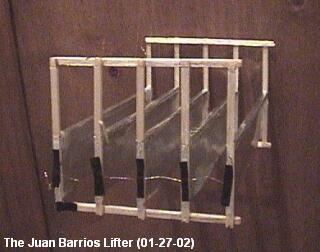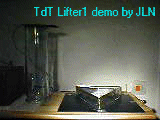
Successful working Lifters
by Juan Barrios ( Buenos Aires, Argentina )

Successful working
Lifters
by
Juan Barrios ( Buenos Aires, Argentina )
created on
January 29, 2002 - JLN Labs -
Last update January 29, 2002
All informations in this page are published free and
are intended for private/educational purposes and not for
commercial applications
|
||||||||||
Hi JLN,
I'm was impressed with your work on you site since 1996-7, when I see it for first time, and I'm very grateful for all you effort on every experiment, test, etc as it must take a lot of time (and money) thanks you!
Today I was testing another configuration for the
lifter (see pic below). It has 5 basic cells, spaced 2 cm, plate
is 3 cm tall x 15 cm cocking aluminium, wire is thin nude copper
3-3.5 cm above the plate, frame of balsa wood. Flyes very well,
very powerful compared to the triangle lifter (that I build
first, see photos), but a bit unstable.
Power supply was a DC (how do you pulsed the HV??), flyback, 2 x
3055 and tripler type, connected to around 30v.
HV was 30kv I think (sparks very bright of 3 cm), I don't take
measuraments to it, nor at the weight.
All pics are of the unconnected device. There are movies if
someone ask, drop me a line.
Thanks again, Juan Barrios, Buenos Aires, Argentina (latittude 34, long. 58) :-)
|
||||||||||
Hi all,
I've tested another lifter configuration, with 5
parallel cells. It was a bit unstable but clearly powerful.
Cells are spaced 20mm and are 30 x 150 mm cocking aluminium, wire
is nude copper, distance to the negative plate is 30 mm.
Frame is balsa wood 3 x 3 mm. HV is DC around 30 Kv.
You can see the unconnected device here: 1
2
3
4
the flying device here: 5
6
and videos here: 1
2
3
Please any comments are welcomed.
Regards, Juan Barrios
See also the :
 Lifters builders
and tests feed-back
Lifters builders
and tests feed-back ![]()
Return to the Lifters Builders page